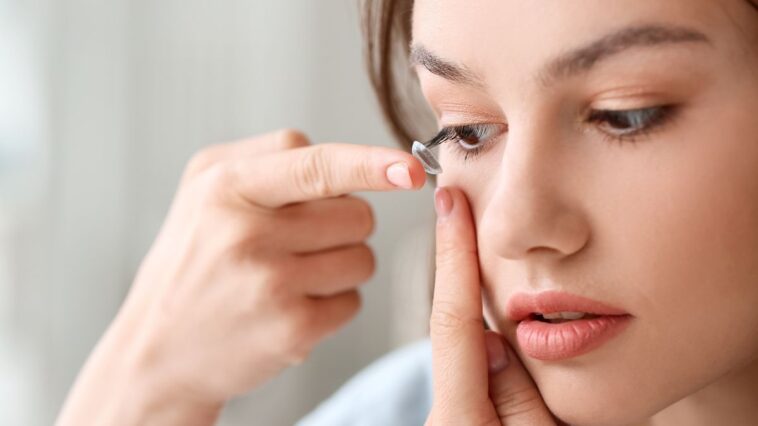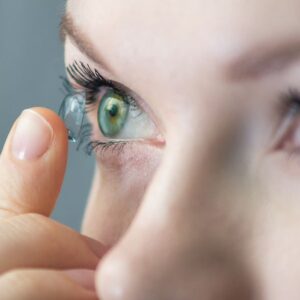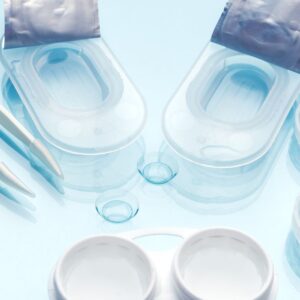What Are Contact Lenses for Dry Eyes?
Contact lenses for dry eyes are a special type of contact lens designed to provide added comfort for individuals who suffer from dry eye syndrome. A dry eye is a condition that occurs when the eyes do not produce enough tears or evaporate too quickly. This can lead to discomfort, irritation, and even vision problems.
Contact lenses for dry eyes are typically made from materials that retain moisture better than traditional contact lenses, such as silicone hydrogel. These materials help to keep the eyes hydrated and prevent dryness.
Some contact lenses for dry eyes also feature higher oxygen permeability to promote healthy eyes. Daily disposable contact lenses can also be a good option as they don’t require cleaning or disinfecting, which can cause more irritation to dry eyes.
It is essential to consult with an eye specialist to determine the best type of contact lens for your specific case of dry eye.
How Do Dry Eye Contact Lenses Work?
Dry eye contact lenses retain moisture in the eyes and reduce the evaporation of tears. They are typically made from materials with higher water content, such as silicone hydrogel, which helps keep the eyes hydrated and prevent dryness. These materials are also more permeable to oxygen, which helps to promote healthy eyes.
Additionally, some dry eye contact lenses have a special coating or surface that helps to retain tears on the surface of the lens, which can help to provide added comfort.
Some other dry-eye contact lenses have designs that mimic the eye’s natural lubrication. They also have special features that reduce friction on the eye’s surface, which can help reduce irritation and discomfort.
It’s important to note that these contact lenses are specially designed for people with dry eyes and are not recommended for people who do not have this condition.
Who Should Use Contact Lenses for Dry Eyes?
Contact lenses for dry eyes are typically recommended for individuals diagnosed with dry eye syndrome. This condition occurs when the eyes do not produce enough tears or the tears evaporate too quickly.
Symptoms of dry eye syndrome can include discomfort, irritation, redness, and even vision problems. People who have dry eyes caused by a medical condition, such as Sjogren’s syndrome, or caused by certain medications, like antihistamines, antidepressants, or birth control pills, are also good candidates for using contact lenses for dry eyes.
Additionally, people who use contact lenses for long periods or have an environment that can cause dry eyes, such as air conditioning, computer use, or windy conditions, may also benefit from using contact lenses for dry eyes.
These lenses are designed to provide added comfort and hydration for dry eyes, which can help to reduce discomfort and improve vision.
However, it is essential to note that only some people with dry eyes will benefit from contact lenses for dry eyes. In some cases, alternative treatment options may be more appropriate.
You must consult an eye specialist to determine if contact lenses for dry eyes are appropriate for you and which type of lens will work best for your specific case of dry eye.
Types of Contacts Available for Dry Eyes
Several types of contact lenses are available for dry eyes, including:
- Silicone hydrogel contact lenses: These lenses are made from a material that allows more oxygen to reach the eye, which can help to promote healthy eyes and reduce dryness. They also retain moisture better than traditional contact lenses.
- Daily disposable contact lenses: These lenses are worn for a single day and then discarded, which reduces the need for cleaning and disinfecting, which can irritate dry eyes.
- Lenses with built-in wetting agents: Some contact lenses have a special coating or surface that helps retain tears on the lens surface, which can help provide added comfort for dry eyes.
- Lenses with higher water content: These lenses are designed to retain more moisture, which can help to keep the eyes hydrated and reduce dryness.
- Hybrid contact lenses: These lenses have a hard center surrounded by a soft skirt, which can help reduce friction on the surface of the eye, which can help to reduce irritation and discomfort for dry eyes.
- Gas Permeable Lenses: These lenses are more durable and can be customized to correct more complicated prescriptions. They are also more oxygen permeated, which can help promote healthy eyes.
Not all contact lenses are appropriate for all cases of dry eye, and it is essential to consult with an eye specialist to determine which lens will work best for your specific case of dry eye.
Potential Risks and Side Effects of Wearing Contacts
Wearing contact lenses can have potential risks and side effects, including:
- Allergic reactions:
Contact lenses can be a great way to correct eyesight and look stylish, but they come with potential risks. One of the most common problems is an allergic reaction, which an allergy can caused to the materials used in the lenses. Symptoms may include redness, itching, and discomfort.
- Eye infections:
Contact lenses can potentially cause eye infections if not properly cared for. These infections, such as conjunctivitis, corneal ulcers, and keratitis, are caused by bacteria, viruses, and fungi. If left untreated, these illnesses can cause permanent damage to the eyes. Therefore, it is essential to take proper care of contact lenses and seek medical attention if any signs of infection occur.
- Dry eyes:
Some people may experience dry eyes when wearing contact lenses, particularly if they have a pre-existing condition that leads to dry eyes or if they wear their contacts for extended periods.
- Scratches on the cornea:
Wearing contact lenses can be dangerous if done incorrectly, exposing the cornea to potential scratches and abrasions. Eye irritation and pain can occur if contacts are not inserted or appropriately removed, which could impair vision.
It is essential to follow the instructions given by doctors and manufacturers when dealing with contact lenses to avoid any potential damage.
- Vision problems:
Contact lenses can relieve vision issues but risk causing problems such as blurry vision, double vision, or seeing halos around lights. Therefore, it is vital to have regular eye exams and wear contact lenses properly for the best results.
- Corneal neovascularization:
One of the potential risks associated with contact lenses is corneal neovascularization. If contact lenses are worn for prolonged periods, it can trigger the growth of new blood vessels in the cornea. This can lead to inflammation and scarring, decreasing vision, or even loss of sight.
- Overwear:
Contacts should not be worn for too long as they can result in several negative side effects, such as dry eyes, irritation, and infection.
Wearing the contacts for too long can cause detrimental damage to the eye, so it is essential to follow your optometrist’s instructions and remove them at the designated time frame.
It’s essential to follow the instructions provided by your eye doctor and the manufacturer of the contact lenses regarding the appropriate use and care of the lenses and to promptly report any adverse side effects or problems to your eye doctor.
It is important to get regular eye exams to maintain good vision and check the health of your eyes. Eye exams can also ensure that contact lenses fit properly, giving you the best possible results.
How often Should You Replace Your Contact Lenses?
The frequency at which you should replace your contact lenses for dry eyes depends on the lens you are using and the recommendation of your eye doctor. Some contact lenses for dry eyes are designed to be replaced daily, while others can be worn longer.
- Daily disposable contact lenses:
These lenses are an excellent choice for individuals with dry eyes. These lenses are used once and thrown away, so no cleaning or disinfecting is required, which makes them ideal for people with eye sensitivity. Additionally, since they only need to be worn once daily, daily disposables can save time and money.
- Monthly disposable contact lenses:
These lenses are made to be worn once a month before being discarded and replaced. These lenses are great for dry eyes, providing maximum moisture retention and higher oxygen permeability. This helps to ensure eye health is maintained.
- Two-week disposable contact lenses:
These lenses are the perfect solution for dry eyes, designed to last for two weeks; these lenses provide extended comfort and stay moist due to their higher oxygen permeability. They also promote healthy eye conditions, making them an excellent choice for anyone looking for reliable eyewear.
- Extended-wear contact lenses:
This lens type is specially formulated to permit more oxygen to flow through the lens and help minimize dryness while maintaining moisture. These lenses are designed for extended periods, usually up to seven days at a time.
While they offer advantages, they can also carry an increased risk of complications such as eye infections or corneal ulcers, so it’s essential to be careful when using them.
It is important to consult your eye doctor to determine the best replacement schedule for your contact lenses for dry eyes based on your specific needs and the lens you are using.
Summary
Contact lenses can be a good option for people with dry eyes as long as they are properly fitted and cared for.
It is important to talk to an eye specialist to determine the best lens type for your specific condition and to learn how to properly care for and use the lenses.
It is also important to be aware of the symptoms of dry eyes, such as itching, burning, and redness, and to remove the lenses if these symptoms occur.
Additionally, frequent eye drops or artificial tears can help relieve dry eye symptoms while wearing contact lenses.






